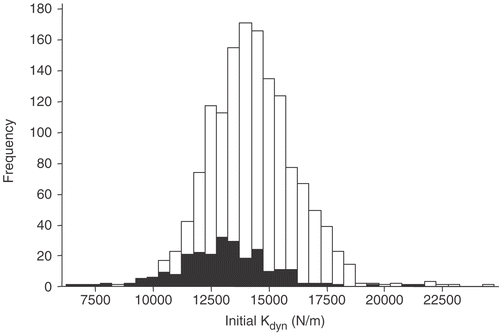Figures & data
Figure 1. Frequency distribution of initial K dyn (N/m) for intact eggs and cracked eggs. Intact eggs white bars, cracked eggs solid bars.

Table The estimated effects, along with their standard errors for logistic regression on the probability of cracking (Pr(Crack)) vs dynamic stiffness (K dyn)
Figure 2. Graph of the fitted probability of cracking (Pr(Crack)) vs K dyn (N/m) for the model excluding egg weight. The different visits are indicated by the colour of the lines: first visit, black lines; second visit, grey lines. The combined tier effect is indicated by the line style: tiers [1, 2, 5 and 6], solid lines; tiers [3, 4, 7 and 8], dashed lines.
![Figure 2. Graph of the fitted probability of cracking (Pr(Crack)) vs K dyn (N/m) for the model excluding egg weight. The different visits are indicated by the colour of the lines: first visit, black lines; second visit, grey lines. The combined tier effect is indicated by the line style: tiers [1, 2, 5 and 6], solid lines; tiers [3, 4, 7 and 8], dashed lines.](/cms/asset/656866f7-ee37-4f27-8b51-9c833c2a3e87/cbps_a_182861_o_f0002g.gif)
Figure 3. Graph of fitted probability of cracking (Pr(Crack)) vs egg weight (g) for the model excluding K dyn. The different visits are indicated by the colour of the lines: first visit, black lines; second visit, grey lines. The combined tier effect is indicated by the line style: tiers [1, 2, 5 and 6], solid lines; tiers [3, 4, 7 and 8], dashed lines.
![Figure 3. Graph of fitted probability of cracking (Pr(Crack)) vs egg weight (g) for the model excluding K dyn. The different visits are indicated by the colour of the lines: first visit, black lines; second visit, grey lines. The combined tier effect is indicated by the line style: tiers [1, 2, 5 and 6], solid lines; tiers [3, 4, 7 and 8], dashed lines.](/cms/asset/d1a579d6-abb0-42e1-9c2c-0a57f0ec7d9b/cbps_a_182861_o_f0003g.gif)
![Figure 4. Contours of the fitted probability of cracking (Pr(Crack)) vs K dyn (N/m) and egg weight (g) for visit 2, and combined tiers [1, 2, 5 and 6]. Values on the contour lines indicate the probability of cracking.](/cms/asset/48983f45-85c3-4869-ae39-1c15058ad411/cbps_a_182861_o_f0004g.gif)
![Figure 5. Fitted probability of cracking (Pr(Crack)) for visit 2 and combined tiers [1, 2, 5 and 6] (solid black line), for the model excluding egg weight, with conservative confidence limits from slope ±2* SE(slope) [dotted grey lines] and deviance-based confidence limits [dashed grey lines].](/cms/asset/50e07584-6f1c-4df3-ba72-81ed574cc7fa/cbps_a_182861_o_f0005g.gif)